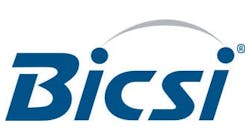Related to
BICSI
Latest from Network Transformation/Edge Compute/IoT/URLLC/Automation/M2M
Category 8 for High-Speed Ethernet of the Future —
Category 8 is finally here! In late 2017, cabling manufacturers will be releasing their initial versions of Category 8 products, the next generation of twisted pair cabling. The highest performance copper wiring, Category 8 offers transmission speeds of 25-40 Gbps (25/40GBASE-T), utilizing bandwidths up to 2 GHz, promising long-term support for future high-speed networks and applications.
Category 8 cabling is made up of 4 shielded-copper twisted pairs that are roughly the same diameter of Category 6a or 7 cabling. The cable has 2 shielding layers (an inner layer of foil sheath for each twisted pair, and an outer braid sheath for the entire cable) to handle the higher energy of 2 GHz transmissions.
Designed to support Ethernet in data centers, Category 8 Class I cabling uses RJ-45 connectors, and has a maximum distance of 30 meters (100 feet). It will be used primarily for switch-to-server connections on the edge of the data center, but is not intended to provide cable for the entire infrastructure.
The cabling industry standards committees have developed and published new standards for Category 8 and 25/40GBASE-T. These include:
• ANSI/TIA-568-C.2-1 updates the established 568-C.2 standard for balanced twisted-pair cabling. This update defines standards for Category 8 channels and permanent links, and includes limits for Resistance Unbalance, TCL, and ELTCTL.
• ISO/IEC 11801-99-1 is the international equivalent of the ANSI/TIA standards, defining Class I/II channels and permanent links.
• IEEE 802.3bq 25G/40GBASE-T defines the minimum transmission characteristics for applications on a twisted pair channel to support 25 Gbps and 40 Gbps over twisted pair cabling.
[toggle title=”Practical Applications for Category 8” load=”hide”]Category 8 cabling will reside at the data center edge, in Equipment Distribution Areas (EDAs) and Horizontal Distribution Areas (HDAs), where Cat6A and 10GBASE-T are currently in use.
Category 8 will be used in the following switch-to-server topologies:
• Top-of-Rack — In configurations where each cabinet has a BASE-T switch at the top, Category 8 patch cords will connect the switch to each server in the cabinet.
• Middle-of-Row — In configurations where a single Middle-of-Row cabinet hosts a BASE-T switch for all servers in that row, Category 8 trunk cables will connect the switch cabinet to the other server cabinets in the row. Also, Category 8 patch cords will connect patch panels at the top of the switch cabinet to the switch below, and connect servers in the other cabinets to patch panels at the top of each server cabinet.
• End-of-Row — Uses the same cabling deployment as the Middle-of-Row configuration, except the single BASE-T switch cabinet is located at the end of the cabinet row.*
*Keep in mind that Category 8 has a distance limitation of 30 meters. If you’re designing a new infrastructure around Category 8, a deployment of cabinet rows with a Middle-of-Row switch may offer more flexibility than a deployment with an End-of-Row switch.[/toggle]
Category 8 vs. Alternatives
For data centers that require mid-to-high level bandwidth over short distance connections, Category 8 provides a longer-length alternative to Direct Attached Copper (DAC) cabling. A twin axial DAC usually has a maximum length of about 7 meters (30 feet), which limits its use to Top-of-Rack configurations where edge switches and servers are connected to each other in the same cabinet or adjacent cabinets. With a distance of up to 30 meters, a Category 8 cable is longer than a twin axial DAC, and can be used in Middle- and End-of-Row applications.
Category 8 also offers a less expensive high-speed alternative to fiber. Although it probably won’t replace fiber in the data center, Category 8 is designed to run applications at both 25 Gbps and 40 Gbps. This fills an industry gap for midlevel bandwidth, since fiber can run only at 10 Gbps and 40 Gbps.
The biggest savings will be related to electronics costs. Although BASE-T switches are initially more expensive than fiber-based or DAC devices, the embedded BASE-T designs use the RJ-45 as the equipment outlet. A pluggable switch requires SFP transceivers, which drives up the cost of twin-axial or fiber connections. As 25G-40G BASE-T switches come into widespread use, it’s expected that switch and server connections supporting them will be much less expensive than those using fiber optics.
As electronics gradually improve from 10GBASE-T to 25G or 40GBASE-T, Category 8 cabling will assist in the migration to higher application transmission speeds. Category 8 can support 10 Gbps applications today, and will support 25 Gbps or 40 Gbps tech refreshes in the future. This prevents the need to re-cable during upgrades, avoiding possible network disruption and additional costs.
Additionally, the 25/40GBASE-T standards support auto-negotiation, which allows 2 connected Ethernet devices to select a common transmission speed. For example, 10 Gbps servers can communicate with 25 Gbps switches over Category 8 connectivity, using the lowest transmission speed (in this case, 10 Gbps) that both can support. This provides a convenient path for network migration to 40GBASE-T in stages, giving the data center owner more flexibility in timing, while minimizing disruption and cost.
Category 8 Testing: Standards and Procedures
Along with the standards for Category 8 cabling, the standards for field testing of cabling have been updated to support Category 8. This was necessary to ensure that testing tools will accurately measure Category 8 cable performance, regardless of manufacturer.
The updated standards include:
• ANSI/TIA 1152-A, an update to the 1152 standard for field test devices used to test balanced twisted-pair cabling, provides specifications for instruments used to test Category 8 cabling.
• IEC 61935-1, the international equivalent of the 1152-A testing standard, was also updated.
It’s important to understand that field devices designed to certify lower category-rated cabling are not capable of certifying Category 8. You can’t simply increase the frequency range to 2GHz on a Category 6A testing module and get accurate Category 8 measurements. Therefore, cable testing manufacturers must develop new testing devices for Category 8.
The measurements you make for Category 8 are the same kinds of measurements that you make for other kinds of cabling, but with some key differences:
• Frequency Range — Category 8 has a frequency range of 2 GHz, instead of 500 MHz. Therefore, a proper testing device will have an increased frequency range.
• Accuracy — There are accuracy specifications that cover that 2 GHz range, which must be included in order to measure cabling to Category 8 standards. (Accuracy specifications are very hard for end users to verify. It’s recommended that before buying a Category 8 cable tester, you look for an independent, third-party verification of the device’s accuracy for its frequency range and measurements.)
• Shield Integrity — Again, Category 8’s shielding layers are designed to handle the higher energy of 2 GHz transmissions. The new testing standards say that Category 8 shielding must be verified as connected and continuous along the path of the cabling. Make sure your Category 8 testing device has the ability to test the shield along the cabling path, and won’t be fooled by adjacent paths such as groundings or shields on adjacent cables.
• Field Adapters — With a Category 8 testing device, it’s essential to have adapters that can connect to a Category 8 modular plug or jack while meeting the 2 GHz frequency range. Unless the testing device has these adapters, it will not be useful for testing field installations of Category 8 cabling.
Finally, certain performance requirements (i.e., transverse conversion loss, resistance unbalance between pairs) have been specified for the first time in Category 8 cabling standards. While these tests are considered optional for field testing, it’s highly recommended that contractors include these tests, to give their clients assurance that the installed Category 8 cabling is working properly, and can handle the client’s applications.
About the Authors:Mark Mullins is one of the founding members of Fluke Networks, starting in 1993. As Fluke Networks’ Field Marketing Manager, he is responsible for building engagement with customers and sales teams across the Americas. For more information, please visit www.flukenetworks.com.








